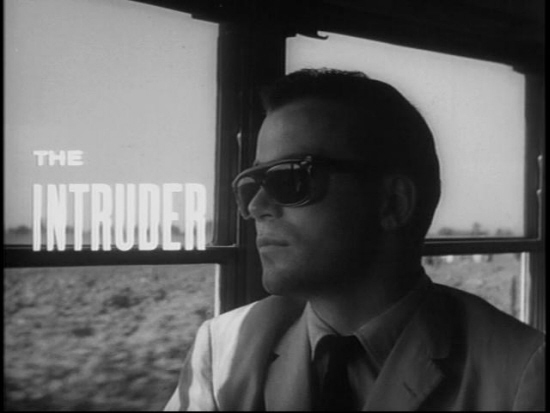Dir.: Roger Corman
Plot: A small Southern town bubbling with resentment at new racial integration laws boils over after the arrival of a smooth-talking white supremacist who stirs up a frenzy beyond his control.
I don’t know if it was the knowingly provocative subject matter, the gaudy re-titlings or the presence of William Shatner that always made me think that this was a schlocky hixploitation picture bashed out to cash in on the Civil Rights movement. I confess I expected to see at least one corrupt overweight sheriff lean back in his desk chair, shoot a mouthful of tobaccy juice into a spittoon and say “Waaall, I’d sure like to help you, boy. But you see, we folks got a way of doin’ things round here…”. However, having now seen the film (albeit a very battered print), I can confirm that Roger Corman’s The Intruder (released several times under different names in a failed attempt to break even) is by no means a trashy race-hate potboiler. On the contrary, it is a very fine, powerful drama with a documentary feel in its raw, ragged glimpses of white Southern anger.
That isn’t to say it doesn’t adopt some of the clichés that would later make provide the backbone of films such as In The Heat of the Night or Mississippi Burning. The South does indeed swelter and sweat in every scene, ugly old white people growl the word ‘nigger’ frequently and a lot of white linen suits make an appearance.
The most notable of these is worn by no other than William Shatner, the ultimate symbol of a film that should have been hammy and daft, but actually isn’t. Watching his pre-Trek turn here, one can understand why as a youth he was considered one of Canada’s most promising dramatic actors. Hypnotisingly charismatic, a manipulative master of inflammatory rhetoric and yet weak at the centre, his Adam Cramer is a vicious snake of a man. He arrives in a small Missouri town on the verge of integrating its school on behalf of a shady organisation trying to whip up ‘resistance’ to the evils of race-mixing. His impassioned, vituperative speeches strike a chord with the barely-contained resentment of the townsfolk. To see Shatner tackle his key address to the people is really seeing something – the vitriol just spews out of him, seemingly uncontrollably, as he shrieks and contorts like a man possessed in his denunciation of desegregation. It should be hammy, but it doesn’t come off that way at all – maybe because his frenzy seems to mimic that of an Evangelical preacher and therefore seems to gel with our understanding of the South. Either way, it is a shivers-down-the-spine moment as he preaches his message of hate to the baying approval of the crowd. The camerawork reinforces this unsettling feeling, gazing up adoringly at Cramer in a manner which immediately calls to mind the Nazi propagandists.
Everyone is taken by Cramer’s performance in but the town’s newspaper editor, a ‘moderate’ racist who is slowly awakened to the danger of blind bigotry until he finds himself drawn towards the struggle of the ten black students braving mob menace to enter the newly-integrated school. However, menace turns to direct violence as the fire lit by Cramer’s hate preaching begins to spread out of control, least of all the control of Cramer himself, who can only look on as his vision of planned tactical resistance descends into a campaign of carnage and terror against the town’s black population.
Particularly victimised is Joe Greene (an excellent Charles Barnes, in reality not an actor but a local high school honor student who left to study Engineering after the film's completion), who returns to school even after the black church is firebombed and is rewarded by being falsely accused of rape. His unimaginable courage as he sits in the principal's office with a lynch mob outside readying to storm the school and take him away makes a beautiful contrast with Cramer, who is shown to be nothing more than a loud-mouthed coward who by the end of the film, his lies and machinations exposed, is left as pathetic and helpless as a child - emphasised by the final shot of him wandering aimlessly around a swing set.
The Intruder is by no means a perfect picture. We get very little insight into Shatner’s motivations in stirring up so much hatred, although it could well be said that this makes his presence all the more menacing. The same defence cannot be applied to a rather out-of-place subplot concerning his seduction of a married woman living in his boarding house. It doesn’t really go anywhere and doesn’t fit into the narrative of the film (unlike, say, his seduction of the reporter’s daughter, which becomes a key plot element), making it an unnecessary distraction from the gripping central action. In fact, the whole narrative feels strangely disjointed and hurried, with some scenes which seem to lead nowhere and yet some others with glimpses of subplots which are never explored. It isn't a long film, at a cool 84 minutes, and the focus is largely on Cramer's scheming, so we never really get to grips with any of the characters in a meaningful way.
However, these criticisms are thoroughly outweighed by positives – a handful of sterling performances, gritty documentary cinematography, and a portrayal of the Civil Rights South which manages to walk the impossibly delicate line between unflinching honesty and redneck stereotyping.
7.5/10
7.5/10




No comments:
Post a Comment